20 Favorite Flowers for the Fall Landscape
http://decor-ideas.org 09/14/2013 18:30 Decor Ideas
Gardeners tend to get excited about spring, looking forward to trying out new plants and maybe even making a big move and changing their landscapes. And in summer there’s the joy of the garden in full bloom, and most fruit trees and vegetable gardens produce abundantly. By September, though, even the most avid gardener can start to feel worn out, and the best-tended garden can start to look a little tired.
That’s too bad, because gardening in the fall can be delightful. The weather is generally cooler than in summer (except in places like San Francisco), yet the garden doesn’t need as much care as in the spring .
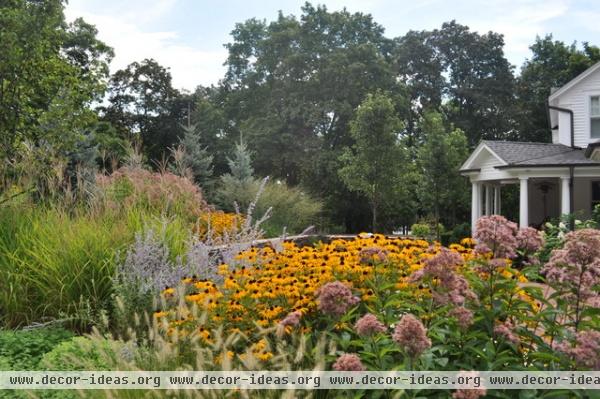
To rejuvenate both your garden and your own gardening enthusiasm, why not plant some fall-blooming annuals and perennials? The annuals may be short lived if you have an early frost, but they’ll certainly brighten things up until then. The perennials might also be low producers this first fall, but think what you’ll have to look forward to in future years.
Those who live in mild-winter or desert climates have it even better; many of these plants will continue blooming into winter.
Some of the plants listed below bloom only in fall. Others may begin their bloom season earlier in the year. And some of the annuals that are normally considered spring flowers will flourish in the cooler fall weather, if only for a short time.
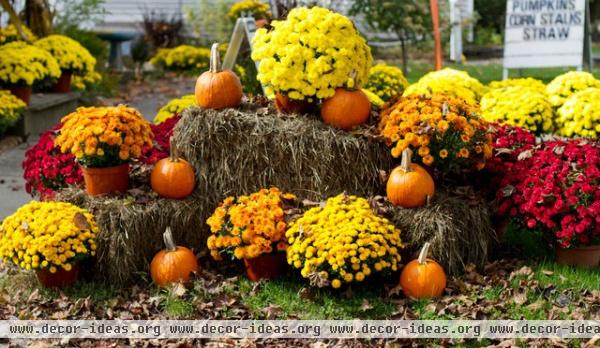
Classic Chrysanthemum
Mums, specifically florists’ or garden mums, have become the go-to plants for a fall garden. You can go with the traditional yellow-, orange- and red-flowered mums or find varieties with flower colors ranging from white to purple. As a bonus, the flower shapes are incredibly varied; you can find quill-like petals, daisy shapes and pom-pom forms. To make the decision even more interesting, heights can range from 1 foot to 6 feet.
Common names: Florists’ chrysanthemum, garden mum
Botanical name: Chrysanthemum x grandiflorum
USDA zones: 4 to 10 (find your zone)
Water requirement: Regular
Light requirement: Full sun
Mature size: 1 foot to 5 feet
Growing tips: Plant blooming varieties in fall in well-draining soil about a month before the first frost for quick color. Then cut them back to about 8 inches above the ground when they finish blooming. Cover with sand, sawdust or a noncomposting mulch if you want. If your soil is very damp through winter or you live in a very cold climate, you may need to dig up the plants and overwinter them aboveground. Divide every few years.
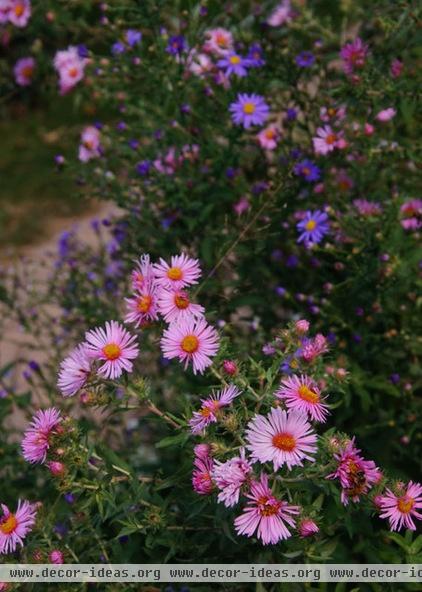
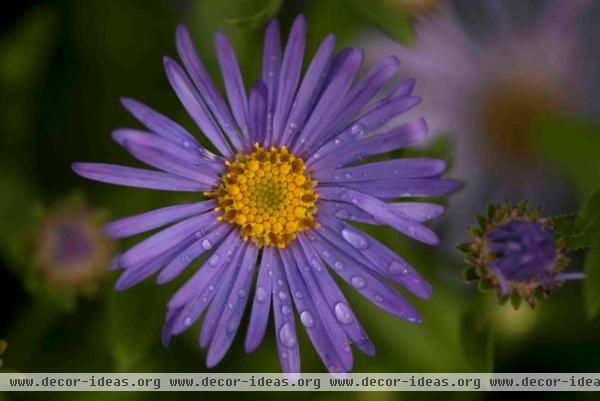
Sturdy Aster
Following closely on the heels of mums in popularity are the asters. There’s a reason these perennials are favorites: Their pink, blue and purple flowers (usually with a bright yellow center) offer a cool contrast to the warmer autumn colors of the changing leaves and grasses. They’re also hardy in almost every climate. Aster x frikartii ‘Monch’ and ‘Wonder of Strafa’ bloom from summer to well into fall, and even through winter in the mildest areas, but they don’t always live as long as other species. The New England aster varieties are notable for their range of colors and their adaptability to wet soils. The similar New York aster, sometimes called a Michaelmas daisy, can range in size from under a foot to 4 feet tall.
Common names: Aster, New England aster, New York aster, Michaelmas Daisy
Botanical names: Aster x frikartii, A. novae-angliae, A. novi-belgii
USDA zones: 3 to 10
Water requirement: Regular
Light requirement: Full sun
Mature size: 1 foot to 5 feet
Growing tips: Fairly tolerant, but grow best in fertile soil. The taller asters may need staking and you may have problems with mildew. Divide if plants become invasive or woody.
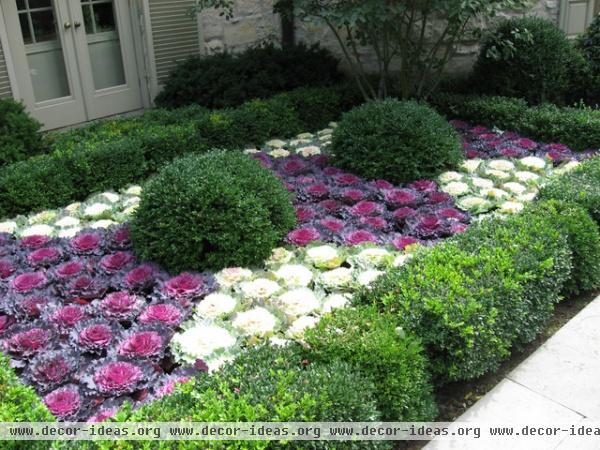
Decorative Flowering Cabbage and Kale
What were once underappreciated vegetables have found their niche as stars of the ornamental fall and winter garden.Their oversize rosette or leafy heads in shades of white, cream, red and purple look like transplants from a giant’s garden. Grow them just as you would their edible cousins, either in the garden or in containers, and don’t worry as the colder weather approaches. They only look better with a touch of frost, as it brings out their color.
Common names: Flowering or ornamental cabbage and kale
Botanical name: Brassica oleracea
USDA zones: All; provide shelter from the sun in hot climates
Water requirement: Regular
Light requirement: Full sun is preferred, but they can take shade.
Mature size: 1 foot to 1½ feet
Growing tips: Set your plants about 1½ feet apart in the garden or add them to containers after the hot weather cools; lightly fertilize throughout the garden season. If you're planting them in the garden, choose a new spot each year, as soil diseases can be a problem. As a plus, while these are “flowering” varieties, their leaves are edible.
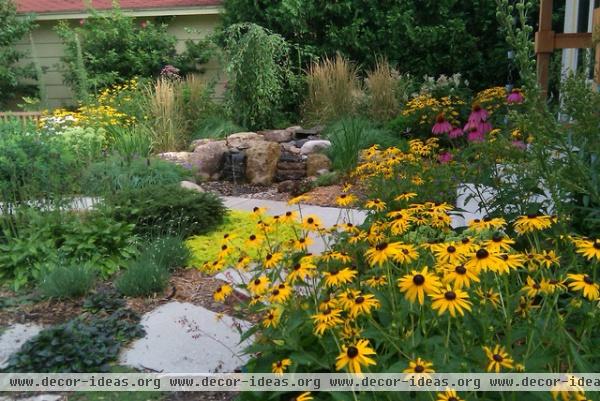
Glorious Black-Eyed Susan
Humans aren’t the only ones who love this plant. Bees, birds and butterflies also flock to it. Plus, it’s easy to grow and can handle tough conditions. Most begin blooming in summer, but the flowering will continue well into fall. There are any number of species available; two of the most popular are ‘Herbstsonne,’ also called ‘Autumn Sun’, and ‘Goldsturm’.
To make things just a bit confusing, one of the common names for these plants is coneflower, a name also given to members of the Echinacea family.
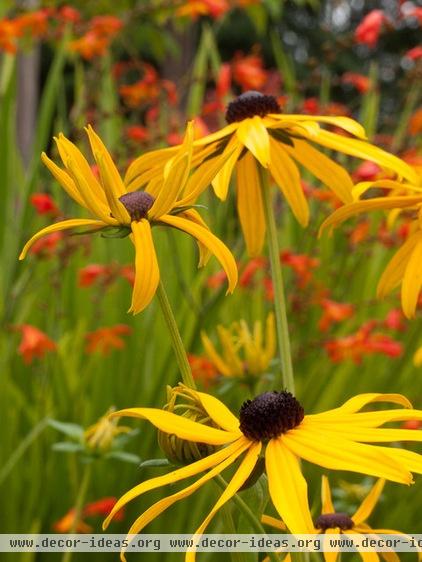
Common names: Black-eyed Susan, gloriosa daisy, coneflower, brown-eyed Susan
Botanical name: Rudbeckia
USDA zones: 3 to 11
Water requirement: Moderate to regular
Light requirement: Full sun to light shade
Mature size: 2 to 10 feet; smaller varieties are now available
Growing tips: These do best their first year if you plant them in spring, but you can still put blooming plants in place in fall for a burst of color. Taller plants may be droopy, so stake them or plant them close enough together that they can provide support without crowding one another. Cut the flowers for arrangements throughout the growing season to encourage continued blooming. Divide when they become crowded.
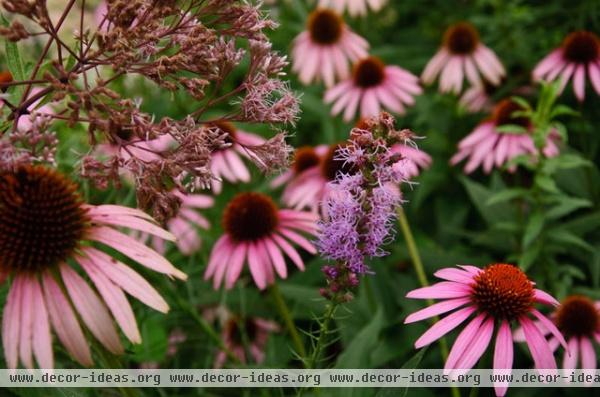
The Other Coneflower
There are plenty of Echinacea species available for home gardeners, but purple coneflower, now available in other colors, is the most popular. It's a hardy perennial with a long blooming season. Not only do the flowers attract butterflies and bees, they’re great cut as well. Take a look at the new hybrids that are even hardier and sport even more colors and flower shapes.
Common names: Purple coneflower, coneflower
Botanical names: Echinacea purpurea, E. hybrids
USDA zones: 3 to 9
Water requirement: Regular to moderate
Light requirement: Full sun
Mature size: 2 to 4 feet
Growing tips: Provide well-drained soil, but otherwise coneflowers will do well almost anywhere in full sun or, in the hottest area, some light shade. They can handle drought conditions as well. Deadhead to keep the flowers coming. Keep the seed heads in place after the flowers fade for birds to enjoy.

Versatile Coreopsis
From spring to fall, coreopsis, also called tickweed, is an easy-care plant whose yellow, orange, red or purple flowers will attract butterflies to almost any garden. And once it has finished blooming, the seed heads will attract birds as well. The annual coreopsis can be grown in all USDA zones, while perennial choices are at home in all but the coldest or hottest climates (think Alaska, southern Texas and southern Florida). For something really unusual, check out C. tinctoria ‘Tiger Stripes’.
Common names: Coreopsis, tickweed, calliopsis
Botanical name: Coreopsis
USDA zones: All, depending on species
Water requirement: Little to moderate
Light requirement: Full sun
Mature size: 1 foot to 2½ feet
Growing tips: Coreposis is generally happy with any soil as long as it drains well. Provide water to establish, then the plants can handle less moisture during the growing season. Deadhead regularly for repeat blooms or leave some blossoms to reseed. This plant self-sows and spreads rapidly, so you may need to divide it every few years.

Easy-Care Sedum
When a plant has a variety named ‘Autumn Joy’, there’s no doubt that it belongs in the fall garden. While ‘Autumn Joy’ is one of the best known of the sedums, a lot of options are available. For the fall garden, hybrid varieties and Sedum spectabile are favorites for humans as well as birds, butterflies and hummingbirds.
Common name: Stonecrop
Botanical name: Sedum
USDA zones: 3 to 10
Water requirement: Regular to moderate, especially once established
Light requirement: Full sun; can take partial shade
Mature size: 9 inches to 3 feet
Growing tips: Sedums are easy to grow and do better in poor dry soil with good drainage than in areas that are very wet. They are reasonably drought tolerant once established. Once the flowers are past their prime, let them dry and use them for indoor flower arrangements. You can cut the plants to the ground in fall or keep them in the garden for winter interest, then cut them back in late winter or early spring.
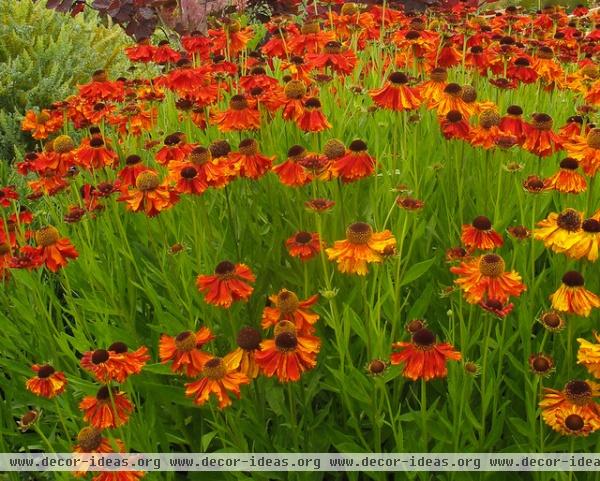
Prolific Sneezeweed
The name is somewhat off-putting, especially if you have allergies, but you might want to overlook that in favor of enjoying the many bright yellow to brownish flowers sneezeweed gladly contributes to the landscape in autumn. You’ll find it sold as H. autumnale, but most of these are actually hybrids. Sneezeweed is another good choice for attracting butterflies and to use for cut flowers.
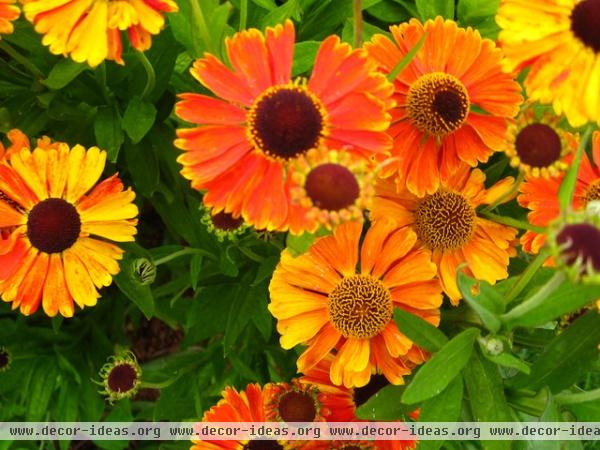
Common name: Sneezeweed
Botanical names: Helenium autumnale, H. hybrids
USDA zones: 3 to 9
Water requirement: Regular
Light requirement: Full sun
Mature size: 3 to 5 feet
Growing tips: All prefer hot summers and soil that drains well but don’t need much fertilizer. Stake the taller types and deadhead to encourage continued blooming.
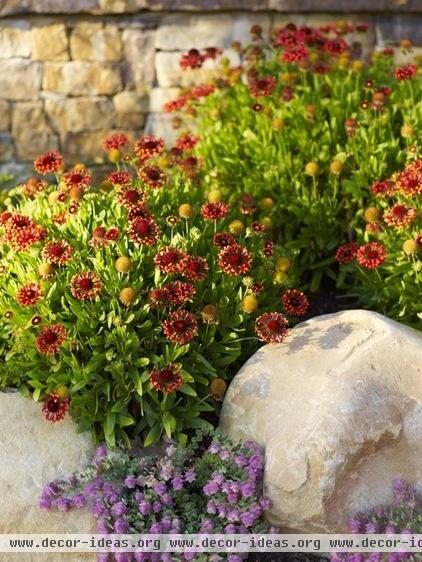
Long-Blooming Blanket Flower
If you want a long-blooming perennial, blanket flower is a top choice. It begins flowering early in the summer and lasts until the frosty weather. During that time flowers in mixes of yellow, orange, red and maroon will attract butterflies. Blanket flower can handle both heat and wind and even tolerate some frost.
Common name: Blanket flower
Botanical name: Gaillardia x grandiflora
USDA zones: All
Water requirement: Moderate
Light requirement: Full sun
Mature size: 2 to 4 feet
Growing tips: Plant it in well-draining soil; you may need to amend heavy clay soil so the roots don’t rot in winter. Blanket flower grows easily from seed and often reseeds. If the plants become too crowded or start to die back, divide in early spring. Cutting for arrangements will encourage repeat blooms.
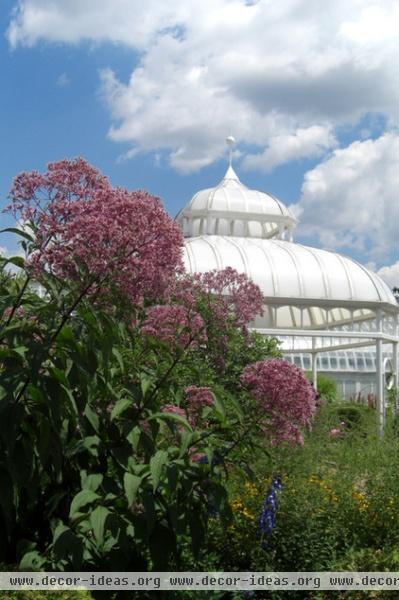
Often-Overlooked Joe Pye Weed
Who Joe Pye was is the subject of debate, but whatever the answer, these large, showy plants that were once considered weeds are now coming into their own. They’re ideal for the back of a border: Even the smaller varieties can reach 6 feet, and the larger ones can grow up to 9 feet tall. The leaves themselves can be a foot in length, and they're topped by masses of tiny purple to white flowers. Bonus: Brush the leaves, and you’ll get a scent of vanilla.
Common name: Joe Pye Weed
Botanical name: Eupatorium purpureum
USDA zones: 4 to 10
Water requirement: Regular to ample
Light requirement: Full sun; light shade where it's very hot
Mature size: 3 to 9 feet
Growing tips: Give these plants plenty of water and rich, moist soil, but as befits their “weed” origin, they don’t need much fertilizer. They are especially at home in meadow gardens and wonderful for attracting butterflies.

Bright Goldenrod
Goldenrods have gotten bad press. For the record, they are not the source of ragweed allergies, so go ahead and plant them for your fall garden. They’re hardy plants that don’t need great soil; they can handle full sun or light shade; the newer hybrids are shorter and more compact than the rangier species; and most of all, when planted in a group, they provide a beautiful golden swath of color that’s a feast for the eyes as well as a food source for birds and butterflies.
Common name: Goldenrod
Botanical name: Solidago
USDA zones: 3 to 10
Water requirement: Moderate
Light requirement: Full sun; can take light shade
Mature size: 2 to 5 feet
Growing tips: Goldenrod grows well in containers as well as poor soil. Blooms usually begin in summer and last into fall. Divide it every few years for best growth.
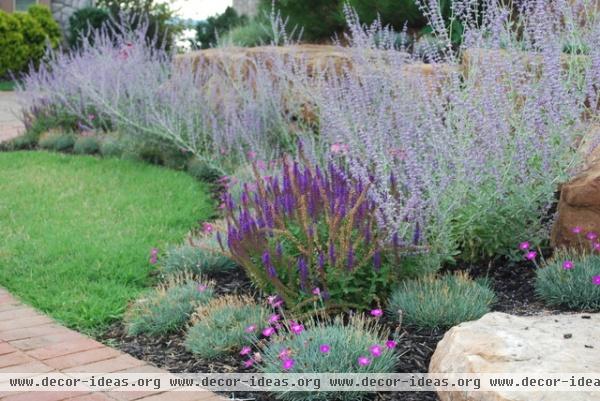
Cloudlike Russian Sage
Looking like a cross between lavender and Mexican bush sage, Russian sage combines fragrant grayish leaves with light purple flower spires, and it has a long bloom season. While it will start blooming in spring and summer, keep cutting off the flowers and you'll get blooms into fall. Once established, Russian sage grows easily, especially in areas with hot summers and little water. In the garden it can be treated as a showy single plant or massed together to create a soft cloud of color that seems to float over nearby smaller plantings.
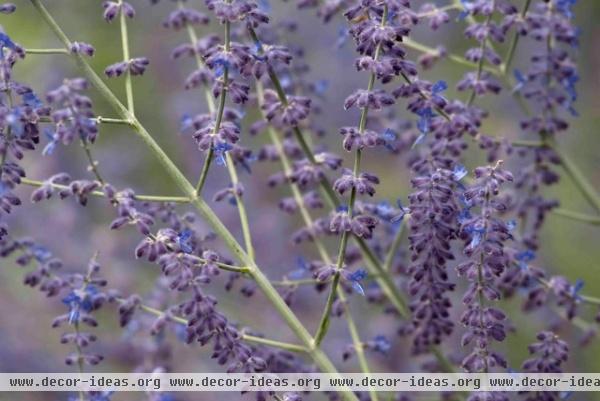
Common name: Russian sage
Botanical name: Perovskia atriplicifolia
USDA zones: 4 to 9
Water requirement: Little to moderate
Light requirement: Full sun
Mature size: 3 to 5 feet
Growing tips: Russian sage will take almost any soil and often spreads easily. If you're planting it en masse, place the plants close enough that they can support one another, as single plants may droop. For best blooms, cut the plants back near the ground before they begin to flower in spring.
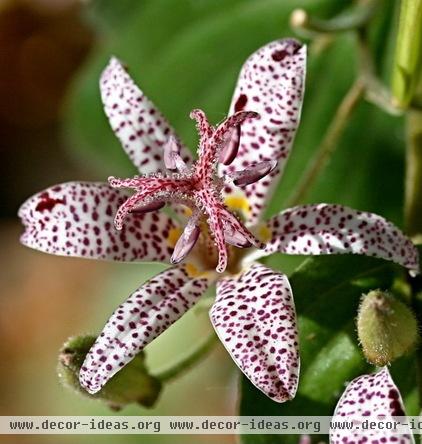
Complex Toad Lily
The name may not be inviting, but toad lily is the perfect addition to a woodland garden. It fits in well with shade-loving foliage plants, such as ferns, its pale green leaves contrasting with darker greens around it. At the end of summer, almost orchid-like white, pink or purple blossoms spotted with darker purple markings appear along the leaves from base to tip, adding a pop of unexpected color to a shady area.
Common name: Toad lily
Botanical name: Tricyrtis hirta
USDA zones: 4 to 9
Water requirement: Plenty
Light requirement: Light to full shade
Mature size: 3 feet
Growing tips: Provide rich organic soil and plenty of water, especially in sunnier areas. Some varieties have gold-edged leaves, which can really shine in the shade.
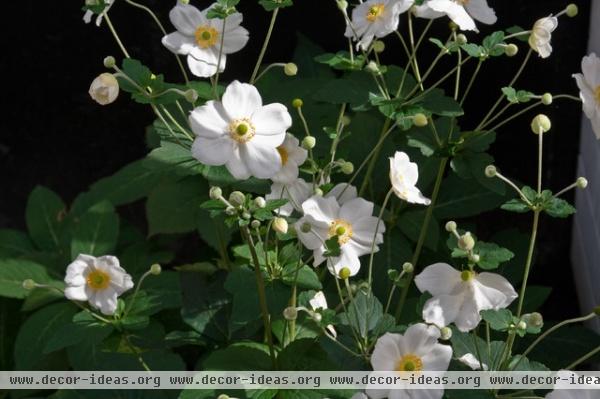
Spectacular Japanese Anemone
This perennial is beginning to play a major role in landscape design. It may take some time for it to get going, but once it settles in, it spreads easily and lasts a long time. The white or pink flowers are standouts, and the plant is large enough to straddle the border between shrub and perennial. Plant it under tall trees or shrubs so it can take advantage of the partial shade while filling in bare spots in the garden.
Caution: Every part of this plant is poisonous if eaten.
Common name: Japanese anemone
Botanical names: Anemone x hybrida, A. japonica, A. hupehensis japonica
USDA zones: 4 to 9
Water requirement: Regular
Light requirement: Partial shade
Mature size: 2 to 5 feet
Growing tips: Don’t grow Japanese anemone in wet soil, as it rots easily, and add protective mulch if you live where the winters are very cold. You may need to stake taller varieties. The plants can be divided in fall or early spring.
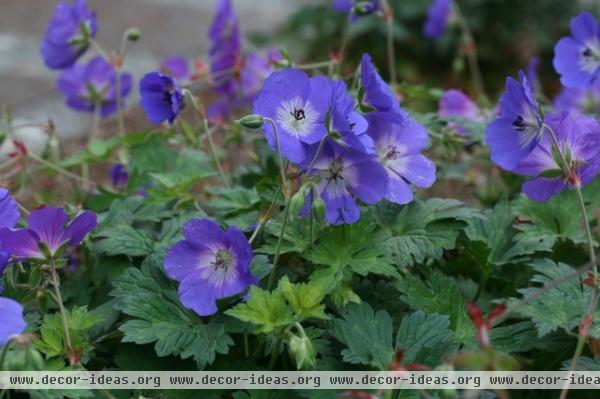
Hardy True Geranium
Familiar geraniums, which are really pelargoniums, may have stolen the name and the spotlight, but the true geranium is making a name for itself amongst gardeners. This mounding perennial adds color to the garden from summer into fall. Different species have different bloom times, but for flowers into the fall, good choices include ‘AnnFolkard’, G. x riversleaianum (a good ground cover choice) and ‘Johnson’s Blue’.
Common names: Hardy geranium, cranesbill
Botanical name: Geranium
USDA zones: 3 to 9
Water requirement: Regular
Light requirement: Full sun to filtered shade
Mature size: 1 foot to 2 feet
Growing tips: True geraniums prefer cooler summers, filtered shade where it’s hot and well-draining soil. The plant will spread easily; deadhead it regularly to keep it blooming and looking good.
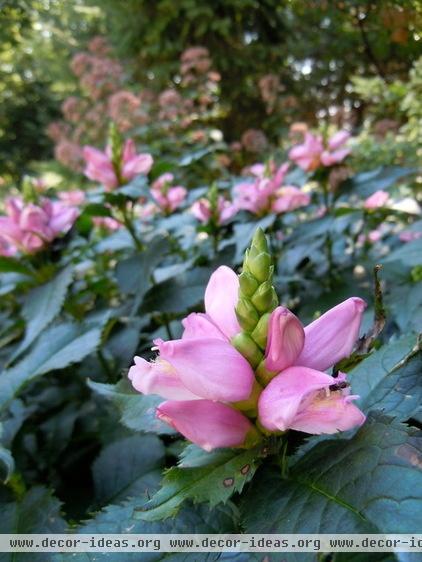
Bog-Loving Turtlehead
So many blooming plants want lots of sun and dry feet, but this native of the U.S. Southeast is happiest in wetter conditions and doesn't mind the shade. It’s ideal for that shady, wet spot in the garden where nothing else seems to grow. Its flowers are relatively small but still pack a punch with their pink color tinged with yellow. It will eventually form clumps.
Common name: Turtlehead
Botanical name: Chelone lyonii
USDA zones: 4 to 9
Water requirement: Plenty
Light requirement: Full sun to light shade
Mature size: 4 feet
Growing tips: Turtlehead doesn’t like heavy soil, so amend the soil before planting. It can take sun as long as you provide plenty of moisture. Divide when the plants become crowded.
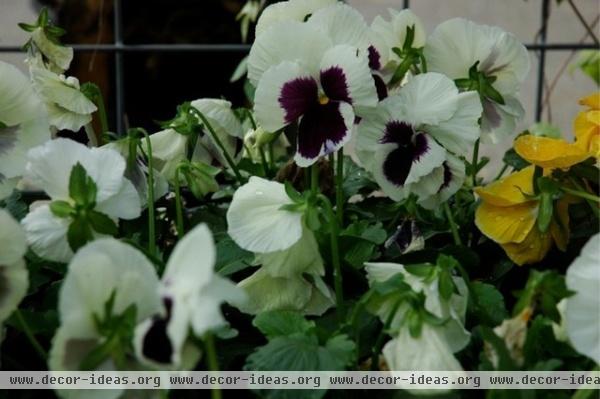
Colorful Pansy and Viola
Though usually planted in winter and spring, these annuals can brighten containers and border edges in fall as well, at least until the frosts get heavy. Although most members of the viola family are usually short-lived perennials, they generally are grown as annuals; the exception for most gardeners is sweet violets. Look for plants in nurseries or start them from seeds.
Common names: Pansy, viola, Johnny-jump-up, sweet violet
Botanical name: Viola
USDA zones: All when grown as an annual
Water requirement: Regular
Light requirement: Full sun to partial shade for pansies; violas prefer shade
Mature size: 3 to 10 inches
Growing tips: For best results, keep your soil moist. If your winters are mild, these plants may last until spring, although they probably won’t last until the following fall. Many are prolific self-seeders.

Shade-Loving Impatiens
Most people think of these as summer plants, but if you need a spot of color, why not stick a six-pack or flat of these in place? Sure, the first frost may do them in, but you can enjoy them until then. If you live where winters are mild, you may even enjoy them through the winter. The good news is that impatiens have one of the largest color ranges of any plants, so you’re sure to find something that will work in your garden.
Common names: Impatiens, balsam, touch-me-not
Botanical name: Impatiens
USDA zones: All, depending on the species
Water requirement: Regular
Light requirement: Shade or partial shade; some can take sun
Mature size: ½ foot to 2 feet
Growing tips: It’s probably best to put out seedlings in the fall. They are fairly low maintenance but will do better if you provide regular fertilizer. Cut them back if they get rangy. All impatiens are great for containers.
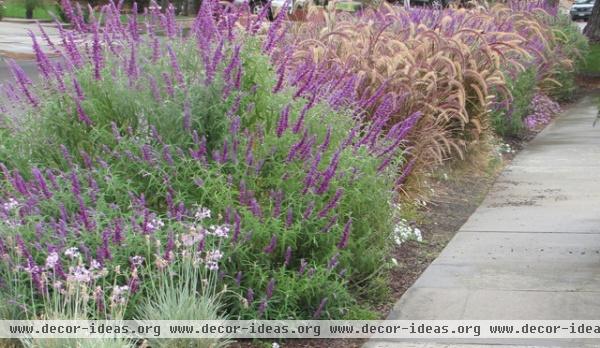
Shrubby Mexican Bush Sage
Really an evergreen shrub rather than a perennial, Mexican bush sage is close enough in general looks to Russian sage and lavender to deserve being mentioned among these other fall bloomers. It’s especially good for mild-winter climates, where it will bloom from fall until spring. It’s a tough plant that can take drought conditions and still look good. It’s also a magnet for birds and butterflies.
Common name: Mexican bush sage, velvet sage
Botanical name: Salvia leucantha
USDA zones: 8 to 10; grow as an annual elsewhere
Water requirement: Light to moderate
Light requirement: Full sun
Mature size: 2½ to 5 feet
Growing tips: Once established, this salvia grows quickly and can take over. Keep it in check by cutting it back in spring and again in summer, if necessary. Cutting back on water will also help keep it from spreading too far. Remove the flower spikes once they begin to fade.
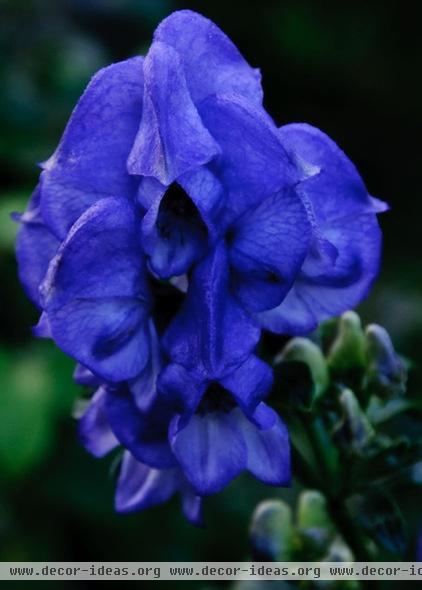
Striking Monkshood
Monkhood’s flowers are so striking that this plant is worth considering for a fall garden. Colors range from white to purple, but it’s the deep blues and incredibly deep purples that really stand out. Monkhoods are a good choice for shady areas, especially at the back of the garden, where you can use their 6- to 8-foot height to advantages. The cut flowers make a strong statement in floral arrangements.
Caution: All parts of this plant are poisonous. Keep it away from children and pets, use gloves when handling the plants and cut flowers, and don’t plant it near edibles, especially root edibles.
Common names: Monkshood, aconite
Botanical name: Aconitum carmichaelii
USDA zones: 3 to 7
Water requirement: Regular
Light requirement: Partial shade; can take full sun depending on location
Mature size: 6 to 8 feet
Growing tips: These plants prefer plenty of water, cooler summers and winter chill; they don’t do well in warmer and drier climates. Provide moist, rich soil. They will die back in winter.
Related Articles Recommended












